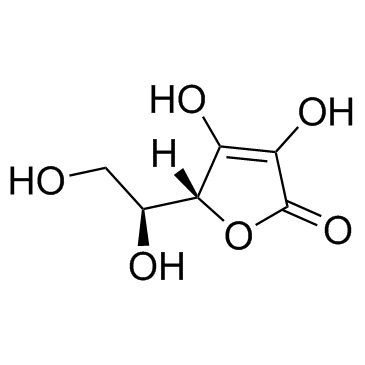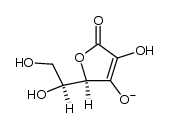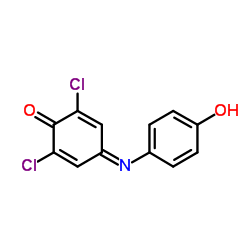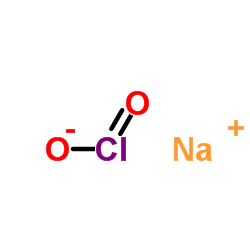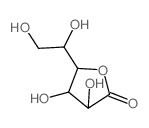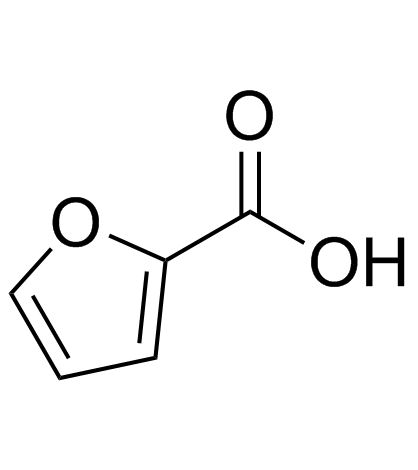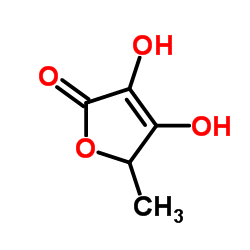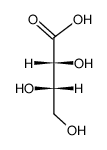490-83-5
| 中文名 | 去氢抗坏血酸 |
|---|---|
| 英文名 | dehydroascorbic acid |
| 中文别名 | 脱氢抗坏血酸 |
| 英文别名 |
L-threo-2,3-Hexodiulosonic Acid g-Lactone
(5R)-5-[(1S)-1,2-Dihydroxyethyl]-2,3,4(5H)-furantrion MFCD00066467 (5R)-5-[(1S)-1,2-Dihydroxyethyl]-2,3,4(5H)-furantrione L-Dehydro Ascorbic Acid DEHYDROASCORBIC ACID EINECS 207-720-6 L-Dehydroascorbic acid L-threo-2,3-Hexodiulosonic acid γ-lactone (5R)-5-[(1S)-1,2-Dihydroxyéthyl]-2,3,4(5H)-furanetrione (5R)-5-[(1S)-1,2-Dihydroxyethyl]furan-2,3,4(5H)-trione (non-preferred name) |
| 描述 | Dehydroascorbic acid,一种可透过血脑屏障的维生素 C 氧化型,对中风具有有效的脑保护作用。 |
|---|---|
| 相关类别 | |
| 靶点 |
Human Endogenous Metabolite |
| 体外研究 | 缺血性中风的神经元损伤部分由细胞毒性活性氧物质介导。虽然抗氧化剂抗坏血酸(AA)或维生素C不能渗透血脑屏障(BBB),但其氧化形式脱氢抗坏血酸(DHA)通过促进转运进入大脑[1]。 |
| 参考文献 |
| 密度 | 1.7±0.1 g/cm3 |
|---|---|
| 沸点 | 389.3±38.0 °C at 760 mmHg |
| 熔点 | 228 °C (dec.)(lit.) |
| 分子式 | C6H6O6 |
| 分子量 | 174.108 |
| 闪点 | 170.0±20.3 °C |
| 精确质量 | 174.016434 |
| PSA | 100.90000 |
| LogP | -2.32 |
| 外观性状 | 白色至浅棕色粉末 |
| 蒸汽压 | 0.0±2.0 mmHg at 25°C |
| 折射率 | 1.570 |
| 储存条件 | -20°C按规格使用和贮存,不会发生分解,避免与氧化物接触 |
| 稳定性 | 按规格使用和贮存,不会发生分解,避免与氧化物接触 |
| 分子结构 | 1、 摩尔折射率:32.74 2、 摩尔体积(m3/mol):99.8 3、 等张比容(90.2K):306.4 4、 表面张力(dyne/cm):88.7 5、 极化率(10 -24cm 3):12.98 |
| 计算化学 | 1、 疏水参数计算参考值(XlogP):-1 2、 氢键供体数量:2 3、 氢键受体数量:6 4、 可旋转化学键数量:2 5、 互变异构体数量:2 6、 拓扑分子极性表面积(TPSA):101 7、 重原子数量:12 8、 表面电荷:0 9、 复杂度:244 10、 同位素原子数量:0 11、 确定原子立构中心数量:2 12、 不确定原子立构中心数量:0 13、 确定化学键立构中心数量:0 14、 不确定化学键立构中心数量:0 15、 共价键单元数量:1 |
| 更多 | 1. 性状:未确定 2. 密度(g/ m3,25/4℃):未确定 3. 相对蒸汽密度(g/cm3,空气=1):未确定 4. 熔点(ºC):228 5. 沸点(ºC,常压):未确定 6. 沸点(ºC,5.2kPa):未确定 7. 折射率:未确定 8. 闪点(ºF):未确定 9. 比旋光度(º):未确定 10. 自燃点或引燃温度(ºC):未确定 11. 蒸气压(kPa,25ºC):未确定 12. 饱和蒸气压(kPa,60ºC):未确定 13. 燃烧热(KJ/mol):未确定 14. 临界温度(ºC):未确定 15. 临界压力(KPa):未确定 16. 油水(辛醇/水)分配系数的对数值:未确定 17. 爆炸上限(%,V/V):未确定 18. 爆炸下限(%,V/V):未确定 19. 溶解性:未确定 |
|
Section 1. Chemical Product and Company Identification Dehydroascorbic acidCatalog DE100 Common Name/ Number(s). Trade Name CAS#490-83-5
Manufacturer RTECSNot available. SPECTRUM CHEMICAL MFG. CORP. TSCATSCA 8(b) inventory: No products were found. Commercial Name(s)Not available. CI# Not available. SynonymL-threo-2,3-Hexadiulosonic acid gamma-lactone IN CASE OF EMERGENCY Not available. Chemical Name Chemical FamilyNot available.CALL (310) 516-8000 C6H6O6 Chemical Formula SPECTRUM CHEMICAL MFG. CORP. Section 2.Composition and Information on Ingredients Exposure Limits TWA (mg/m3)STEL (mg/m3) CEIL (mg/m3) NameCAS #% by Weight 1) Dehydroascorbic acid490-83-5100 Toxicological DataNot applicable. on Ingredients Section 3. Hazards Identification Potential Acute Health Effects Hazardous in case of ingestion. Slightly hazardous in case of skin contact (irritant), of eye contact (irritant), of inhalation. Potential Chronic HealthHazardous in case of ingestion. Slightly hazardous in case of skin contact (irritant), of eye contact (irritant), of inhalation. Effects CARCINOGENIC EFFECTS: Not available. MUTAGENIC EFFECTS: Not available. TERATOGENIC EFFECTS: Not available. DEVELOPMENTAL TOXICITY: Not available. Dehydroascorbic acid Section 4. First Aid Measures Eye ContactNo known effect on eye contact, rinse with water for a few minutes. Skin ContactAfter contact with skin, wash immediately with plenty of water. Gently and thoroughly wash the contaminated skin with running water and non-abrasive soap. Be particularly careful to clean folds, crevices, creases and groin. Cover the irritated skin with an emollient. If irritation persists, seek medical attention. Wash contaminated clothing before reusing. Serious Skin ContactNot available. InhalationAllow the victim to rest in a well ventilated area. Seek immediate medical attention. Serious InhalationNot available. IngestionDo not induce vomiting. Loosen tight clothing such as a collar, tie, belt or waistband. If the victim is not breathing, perform mouth-to-mouth resuscitation. Seek immediate medical attention. Serious IngestionNot available. Section 5. Fire and Explosion Data Flammability of the Product May be combustible at high temperature. Auto-Ignition Temperature Not available. Flash PointsNot available. Flammable LimitsNot available. These products are carbon oxides (CO, CO2). Products of Combustion Fire Hazards in Presence of Not available. Various Substances Explosion Hazards in Presence Risks of explosion of the product in presence of mechanical impact: Not available. of Various SubstancesRisks of explosion of the product in presence of static discharge: Not available. Fire Fighting MediaSMALL FIRE: Use DRY chemical powder. and InstructionsLARGE FIRE: Use water spray, fog or foam. Do not use water jet. Special Remarks onNot available. Fire Hazards Special Remarks on Explosion Not available. Hazards Section 6. Accidental Release Measures Small SpillUse appropriate tools to put the spilled solid in a convenient waste disposal container. Finish cleaning by spreading water on the contaminated surface and dispose of according to local and regional authority requirements. Large Spill Use a shovel to put the material into a convenient waste disposal container. Finish cleaning by spreading water on the contaminated surface and allow to evacuate through the sanitary system. Dehydroascorbic acid Section 7. Handling and Storage PrecautionsKeep away from heat. Keep away from sources of ignition. Empty containers pose a fire risk, evaporate the residue under a fume hood. Ground all equipment containing material. Do not breathe dust. StorageKeep container dry. Keep in a cool place. Ground all equipment containing material. Keep container tightly closed. Keep in a cool, well-ventilated place. Combustible materials should be stored away from extreme heat and away from strong oxidizing agents. Section 8. Exposure Controls/Personal Protection Engineering ControlsUse process enclosures, local exhaust ventilation, or other engineering controls to keep airborne levels below recommended exposure limits. If user operations generate dust, fume or mist, use ventilation to keep exposure to airborne contaminants below the exposure limit. Personal ProtectionSafety glasses. Lab coat. Dust respirator. Be sure to use an approved/certified respirator or equivalent. Gloves. Personal Protection in Case of Splash goggles. Full suit. Dust respirator. Boots. Gloves. A self contained breathing apparatus should be used a Large Spillto avoid inhalation of the product. Suggested protective clothing might not be sufficient; consult a specialist BEFORE handling this product. Exposure LimitsNot available. Section 9. Physical and Chemical Properties Physical state and appearance Solid.Not available. Odor TasteNot available. Molecular Weight174.11 g/mole ColorNot available. pH (1% soln/water)Not available. Boiling PointNot available. Melting PointDecomposes. (225°C or 437°F) Critical TemperatureNot available. Not available. Specific Gravity Vapor PressureNot applicable. Not available. Vapor Density VolatilityNot available. Not available. Odor Threshold Water/Oil Dist. Coeff.Not available. Ionicity (in Water)Not available. Not available. Dispersion Properties SolubilityNot available. Section 10. Stability and Reactivity Data StabilityThe product is stable. Instability TemperatureNot available. Conditions of InstabilityNot available. Incompatibility with variousNot available. substances CorrosivityNon-corrosive in presence of glass. Dehydroascorbic acid Not available. Special Remarks on Reactivity Not available. Special Remarks on Corrosivity PolymerizationNo. Section 11. Toxicological Information Routes of EntryIngestion. Toxicity to AnimalsLD50: Not available. LC50: Not available. Chronic Effects on Humans Not available. Other Toxic Effects on Hazardous in case of ingestion. HumansSlightly hazardous in case of skin contact (irritant), of inhalation. Special Remarks on Not available. Toxicity to Animals Special Remarks onNot available. Chronic Effects on Humans Special Remarks on otherNot available. Toxic Effects on Humans Section 12. Ecological Information EcotoxicityNot available. Not available. BOD5 and COD Possibly hazardous short term degradation products are not likely. However, long term degradation products may Products of Biodegradation arise. Toxicity of the ProductsThe products of degradation are more toxic. of Biodegradation Special Remarks on theNot available. Products of Biodegradation Section 13. Disposal Considerations Waste Disposal Section 14. Transport Information DOT ClassificationNot a DOT controlled material (United States). IdentificationNot applicable. Not applicable. Special Provisions for Transport DOT (Pictograms) Dehydroascorbic acid Section 15. Other Regulatory Information and Pictograms TSCA 8(b) inventory: No products were found. Federal and State Regulations California Proposition 65 Warnings Other RegulationsNot available.. WHMIS (Canada) Not controlled under WHMIS (Canada). Other Classifications DSCL (EEC)This product is not classified according to the EU regulations. Health Hazard HMIS (U.S.A.)1 National Fire Protection 1 Flammability 1 Association (U.S.A.) Fire Hazard 1 0 Reactivity Health Reactivity 0 Specific hazard Personal Protection E WHMIS (Canada) (Pictograms) DSCL (Europe) (Pictograms) TDG (Canada) (Pictograms) ADR (Europe) (Pictograms) Protective Equipment Gloves. Lab coat. Dust respirator. Be sure to use an approved/certified respirator or equivalent. Safety glasses. SECTION 16 - ADDITIONAL INFORMATION N/A |
|
生态学数据: 该物质对环境可能有危害,对水体应给予特别注意。
|
| 上游产品 9 | |
|---|---|
| 下游产品 9 | |



